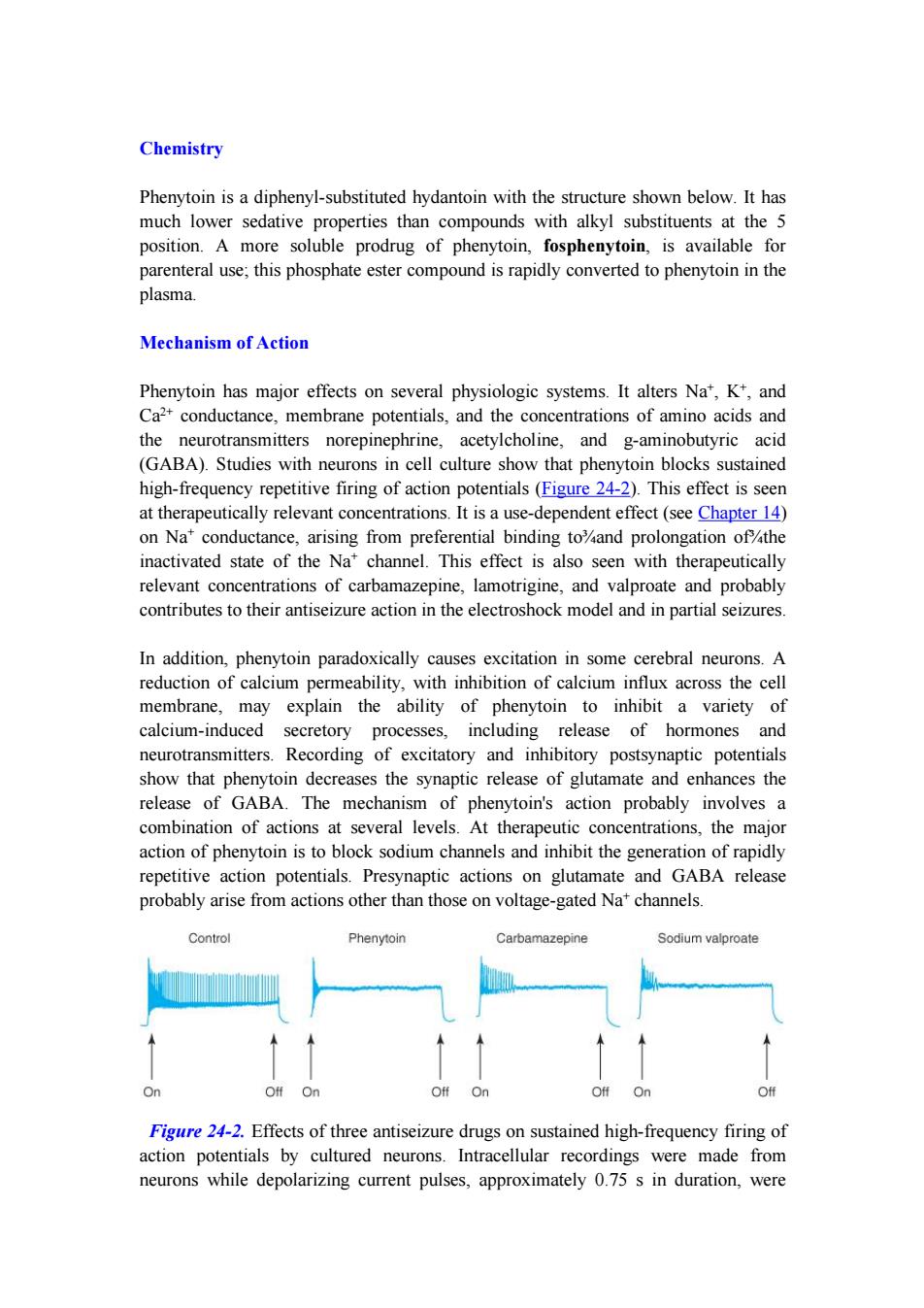正在加载图片...

Chemistry Phenytoin is a diphenyl-substituted hydantoin with the structure shown below.It has much lower sedative properties than compounds with alkyl substituents at the 5 position.A more soluble prodrug of phenytoin,fosphenytoin,is available for parenteral use;this phosphate ester compound is rapidly converted to phenytoin in the plasma. Mechanism of Action Phenytoin has major effects on several physiologic systems.It alters Na',K+,and Ca2+conductance,membrane potentials,and the concentrations of amino acids and the neurotransmitters norepinephrine,acetylcholine,and g-aminobutyric acid (GABA).Studies with neurons in cell culture show that phenytoin blocks sustained high-frequency repetitive firing of action potentials(Figure 24-2).This effect is seen at therapeutically relevant concentrations.It is a use-dependent effect(see Chapter 14) on Na conductance,arising from preferential binding to%and prolongation of the inactivated state of the Na'channel.This effect is also seen with therapeutically relevant concentrations of carbamazepine,lamotrigine,and valproate and probably contributes to their antiseizure action in the electroshock model and in partial seizures. In addition,phenytoin paradoxically causes excitation in some cerebral neurons.A reduction of calcium permeability,with inhibition of calcium influx across the cell membrane,may explain the ability of phenytoin to inhibit a variety of calcium-induced secretory processes,including release of hormones and neurotransmitters.Recording of excitatory and inhibitory postsynaptic potentials show that phenytoin decreases the synaptic release of glutamate and enhances the release of GABA.The mechanism of phenytoin's action probably involves a combination of actions at several levels.At therapeutic concentrations,the major action of phenytoin is to block sodium channels and inhibit the generation of rapidly repetitive action potentials.Presynaptic actions on glutamate and GABA release probably arise from actions other than those on voltage-gated Na'channels. Control Phenytoin Carbamazepine Sodium valproate On Off On Off On Off On Off Figure 24-2.Effects of three antiseizure drugs on sustained high-frequency firing of action potentials by cultured neurons.Intracellular recordings were made from neurons while depolarizing current pulses,approximately 0.75 s in duration,wereChemistry Phenytoin is a diphenyl-substituted hydantoin with the structure shown below. It has much lower sedative properties than compounds with alkyl substituents at the 5 position. A more soluble prodrug of phenytoin, fosphenytoin, is available for parenteral use; this phosphate ester compound is rapidly converted to phenytoin in the plasma. Mechanism of Action Phenytoin has major effects on several physiologic systems. It alters Na + , K+ , and Ca 2+ conductance, membrane potentials, and the concentrations of amino acids and the neurotransmitters norepinephrine, acetylcholine, and g-aminobutyric acid (GABA). Studies with neurons in cell culture show that phenytoin blocks sustained high-frequency repetitive firing of action potentials (Figure 24-2). This effect is seen at therapeutically relevant concentrations. It is a use-dependent effect (see Chapter 14) on Na + conductance, arising from preferential binding to¾and prolongation of¾the inactivated state of the Na + channel. This effect is also seen with therapeutically relevant concentrations of carbamazepine, lamotrigine, and valproate and probably contributes to their antiseizure action in the electroshock model and in partial seizures. In addition, phenytoin paradoxically causes excitation in some cerebral neurons. A reduction of calcium permeability, with inhibition of calcium influx across the cell membrane, may explain the ability of phenytoin to inhibit a variety of calcium-induced secretory processes, including release of hormones and neurotransmitters. Recording of excitatory and inhibitory postsynaptic potentials show that phenytoin decreases the synaptic release of glutamate and enhances the release of GABA. The mechanism of phenytoin's action probably involves a combination of actions at several levels. At therapeutic concentrations, the major action of phenytoin is to block sodium channels and inhibit the generation of rapidly repetitive action potentials. Presynaptic actions on glutamate and GABA release probably arise from actions other than those on voltage-gated Na + channels. Figure 24-2. Effects of three antiseizure drugs on sustained high-frequency firing of action potentials by cultured neurons. Intracellular recordings were made from neurons while depolarizing current pulses, approximately 0.75 s in duration, were